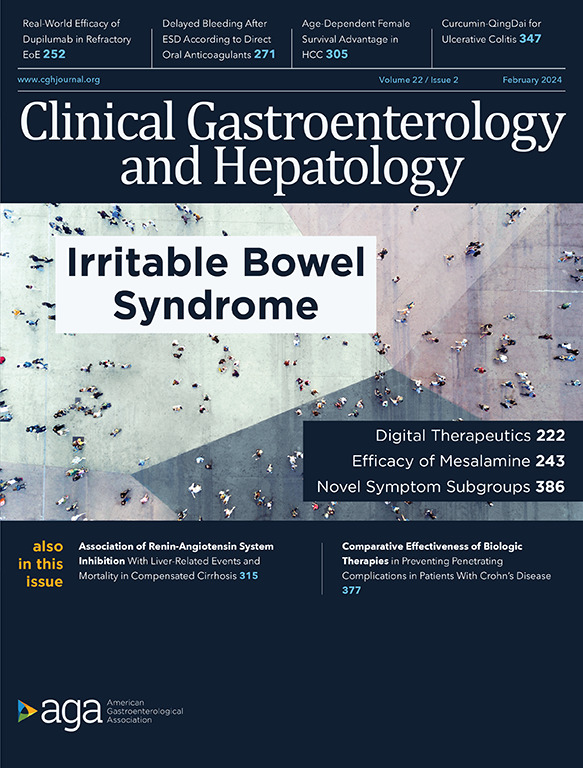Multimodal Pancreatic Cancer Detection Using Methylated DNA Biomarkers in Pancreatic Juice and Plasma CA 19-9: A Prospective Multicenter Study
IF 12
1区 医学
Q1 GASTROENTEROLOGY & HEPATOLOGY
引用次数: 0
Abstract
Background and Aims
In previous studies, methylated DNA markers (MDMs) have been identified in pancreatic juice (PJ) for detecting pancreatic ductal adenocarcinoma (PDAC). In this prospective multicenter study, the sensitivity and specificity characteristics of this panel of PJ-MDMs was evaluated standalone and in combination with plasma carbohydrate antigen 19-9 (CA 19-9).
Methods
Paired PJ and plasma were assayed from 88 biopsy-proven treatment-naïve PDAC cases and 134 controls (53 with normal pancreas, 23 with chronic pancreatitis [CP], 58 with intraductal papillary mucinous neoplasm). Bisulfite-converted DNA from buffered PJ was analyzed using long-probe quantitative amplified signal assay targeting 14 MDMs (NDRG4, BMP3, TBX15, C13orf18, PRKCB, CLEC11A, CD1D, ELMO1, IGF2BP1, RYR2, ADCY1, FER1L4, EMX1, and LRRC4) and a reference gene (methylated B3GALT6). Logistic regression was used to fit the previously identified 3-MDM PJ panel (FER1L4, C13orf18, and BMP3). Discrimination accuracy was summarized using area under the receiver-operating characteristic curve (AUROC) with corresponding 95% confidence interval (CI).
Results
Methylated FER1L4 had the highest individual AUROC of 0.83 (95% CI, 0.78–0.89). The AUROC for the 3-MDM PJ + plasma CA 19-9 model (0.95; 95% CI, 0.92–0.98) was higher than both the 3-MDM PJ panel (0.87; 95% CI, 0.82–0.92)) and plasma CA 19-9 alone (0.91; 95% CI, 0.87–0.96) (P = .0002 and .0135, respectively). At a specificity of 88% (95% CI, 81%–93%), the sensitivity of this model was 89% (95% CI, 80%–94%) for all PDAC stages and 83% (95% CI, 64%–94%) for stage I/II PDAC.
Conclusions
A panel combining PJ-MDMs and plasma CA 19-9 discriminates PDAC from both healthy and disease control groups with high accuracy. This provides support for combining PJ and blood-based biomarkers for enhancing diagnostic sensitivity and successful early PDAC detection.
利用胰液中甲基化 DNA 生物标记物和血浆 CA 19-9 进行多模式胰腺癌检测:一项前瞻性多中心研究。
背景和目的:以往的研究发现,胰液(PJ)中的甲基化DNA标记物(MDMs)可用于检测胰腺导管腺癌(PDAC)。在这项前瞻性多中心研究中,对这组 PJ-MDMs 的灵敏度和特异性特征进行了单独评估,以及与血浆 CA 19-9 联合评估:方法:对 88 例经活检证实的未接受过治疗的 PDAC 病例和 134 例对照(正常胰腺 53 例、慢性胰腺炎(CP)134 例)的配对 PJ 和血浆进行检测:方法:对 88 例经活检证实未接受过治疗的 PDAC 病例和 134 例对照组(正常胰腺:53 例;慢性胰腺炎(CP):23 例;导管内乳头状粘液瘤(IPMN):58 例)的配对 PJ 和血浆进行检测。使用长探针定量扩增信号分析法分析了缓冲 PJ 中的亚硫酸氢盐转化 DNA,该方法针对 14 个 MDMs(NDRG4、BMP3、TBX15、C13orf18、PRKCB、CLEC11A、CD1D、ELMO1、IGF2BP1、RYR2、ADCY1、FER1L4、EMX1 和 LRRC4)和一个参考基因(甲基化 B3GALT6)。逻辑回归用于拟合先前确定的 3-MDM PJ 面板(FER1L4、C13orf18 和 BMP3)。利用接收者工作特征曲线下面积(AUROC)和相应的 95% 置信区间总结了判别准确性:甲基化 FER1L4 的单个 AUROC 最高,为 0.83(95% CI:0.78-0.89)。3-MDM PJ + 血浆 CA 19-9 模型的 AUROC(0.95 (0.92-0.98) )高于 3-MDM PJ 面板(0.87 (0.82-0.92))和单独血浆 CA 19-9(0.91 (0.87-0.96) (分别为 p=0.0002 和 0.0135))。在特异性为88%(95% CI:81-93%)时,该模型对所有PDAC分期的灵敏度为89%(80-94%),对I/II期PDAC的灵敏度为83%(64-94%):结论:结合 PJ-MDMs 和血浆 CA19-9 的面板能准确区分 PDAC 与健康组和疾病对照组。这为结合胰液和血液中的生物标记物提高诊断灵敏度并成功检测早期 PDAC 提供了支持。
本文章由计算机程序翻译,如有差异,请以英文原文为准。
求助全文
约1分钟内获得全文
求助全文
来源期刊
CiteScore
16.90
自引率
4.80%
发文量
903
审稿时长
22 days
期刊介绍:
Clinical Gastroenterology and Hepatology (CGH) is dedicated to offering readers a comprehensive exploration of themes in clinical gastroenterology and hepatology. Encompassing diagnostic, endoscopic, interventional, and therapeutic advances, the journal covers areas such as cancer, inflammatory diseases, functional gastrointestinal disorders, nutrition, absorption, and secretion.
As a peer-reviewed publication, CGH features original articles and scholarly reviews, ensuring immediate relevance to the practice of gastroenterology and hepatology. Beyond peer-reviewed content, the journal includes invited key reviews and articles on endoscopy/practice-based technology, health-care policy, and practice management. Multimedia elements, including images, video abstracts, and podcasts, enhance the reader's experience. CGH remains actively engaged with its audience through updates and commentary shared via platforms such as Facebook and Twitter.

 求助内容:
求助内容: 应助结果提醒方式:
应助结果提醒方式:


